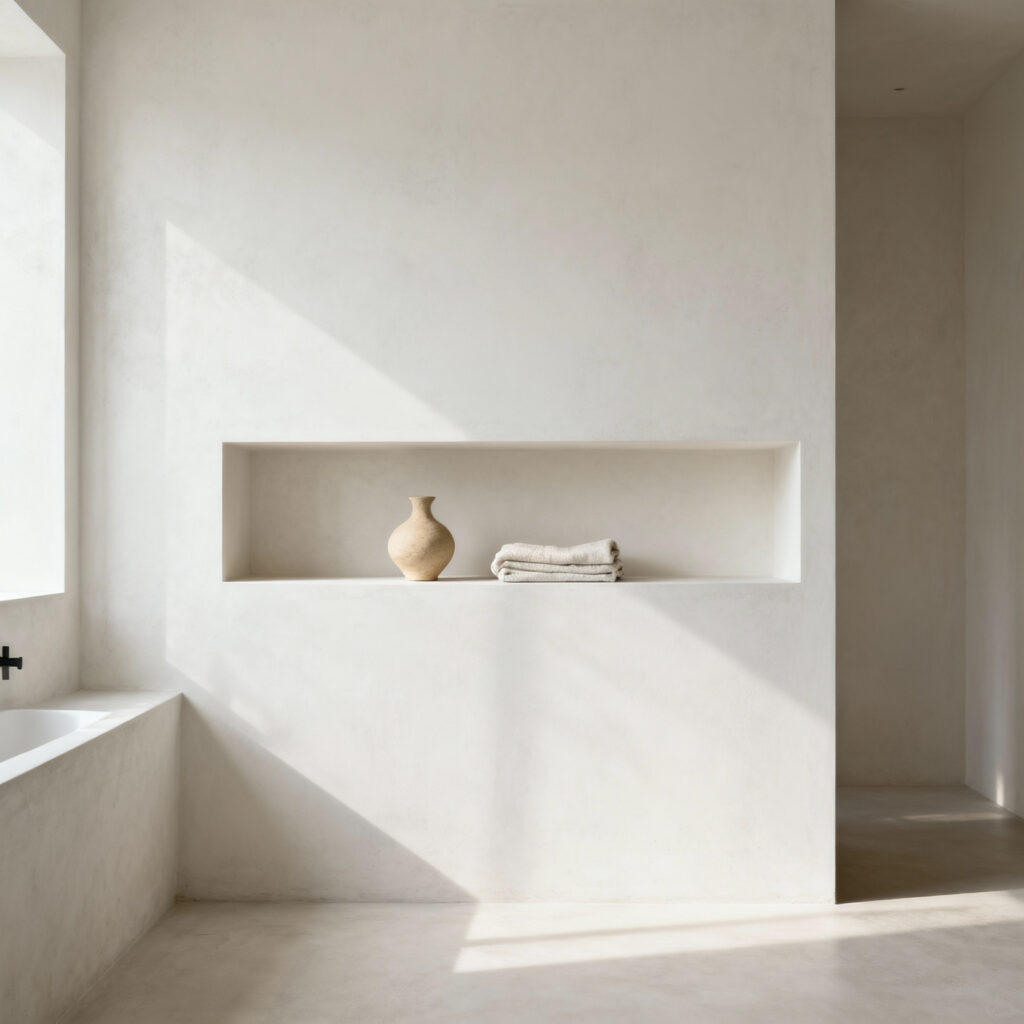Since ancient times in Japan, the home has been understood as a reflection of the inner self. This idea did not begin with design, but with philosophy, evolving from the quiet clarity of Zen temples into the very structure of our living spaces. Today’s most sophisticated environments understand this dual truth: a home must serve our needs, but it must also nurture our spirit. The principles that separate a space of true harmony from one of simple tidiness haven’t changed in centuries.
In my work bridging traditional Japanese architecture with modern life, the bathroom consistently emerges as a space of unique potential. It is often our most private, personal sanctuary. This intimacy means that clutter here is not just a visual problem; it is a spiritual weight. And so, the act of creating effective bathroom storage organization becomes something more profound than mere arranging. It is an exercise in intentionality, a chance to turn a purely functional room into a place of quiet reflection. This dual understanding—that practicality and poetry must walk hand-in-hand—is the very heart of creating a restorative home.
This exploration will guide you through 20 principles, moving from the philosophical currents that shape our thinking to the tangible choices we make. We begin by cultivating serenity, understanding the essence of minimalist cohesion. From there, we will touch upon the importance of tactile tranquility—the materials and forms we choose for our vessels. We then move into spatial synergies, orchestrating the room’s flow, before finally establishing the rituals of a sustained sanctuary. This is an invitation to look at your bathroom not as a room to be managed, but as a space to be understood. Prepare to discover how the art of absence can bring a new, quiet presence to your home.
Cultivating Serenity: Embracing Japanese Principles of Minimalist Cohesion (Part 1)
The bathroom is a space where the day begins and ends. To bring harmony here is to bring harmony to the rhythm of our lives. This requires looking beyond simple neatness to the philosophies that give order its meaning. By understanding concepts like Ma and Wabi-Sabi, we elevate the task of organization into an art form, turning daily routines into moments of peace.
1. Embrace Ma and the Beauty of Negative Space for Visual Calm
The Japanese concept of Ma is not emptiness; it is the purposeful, resonant space between things. In music, it is the silence that gives notes their power. In a room, it is the uncluttered surface that allows an object to be truly seen. This principle teaches us that what is left out is as important as what is put in. Ma is the visual breath.
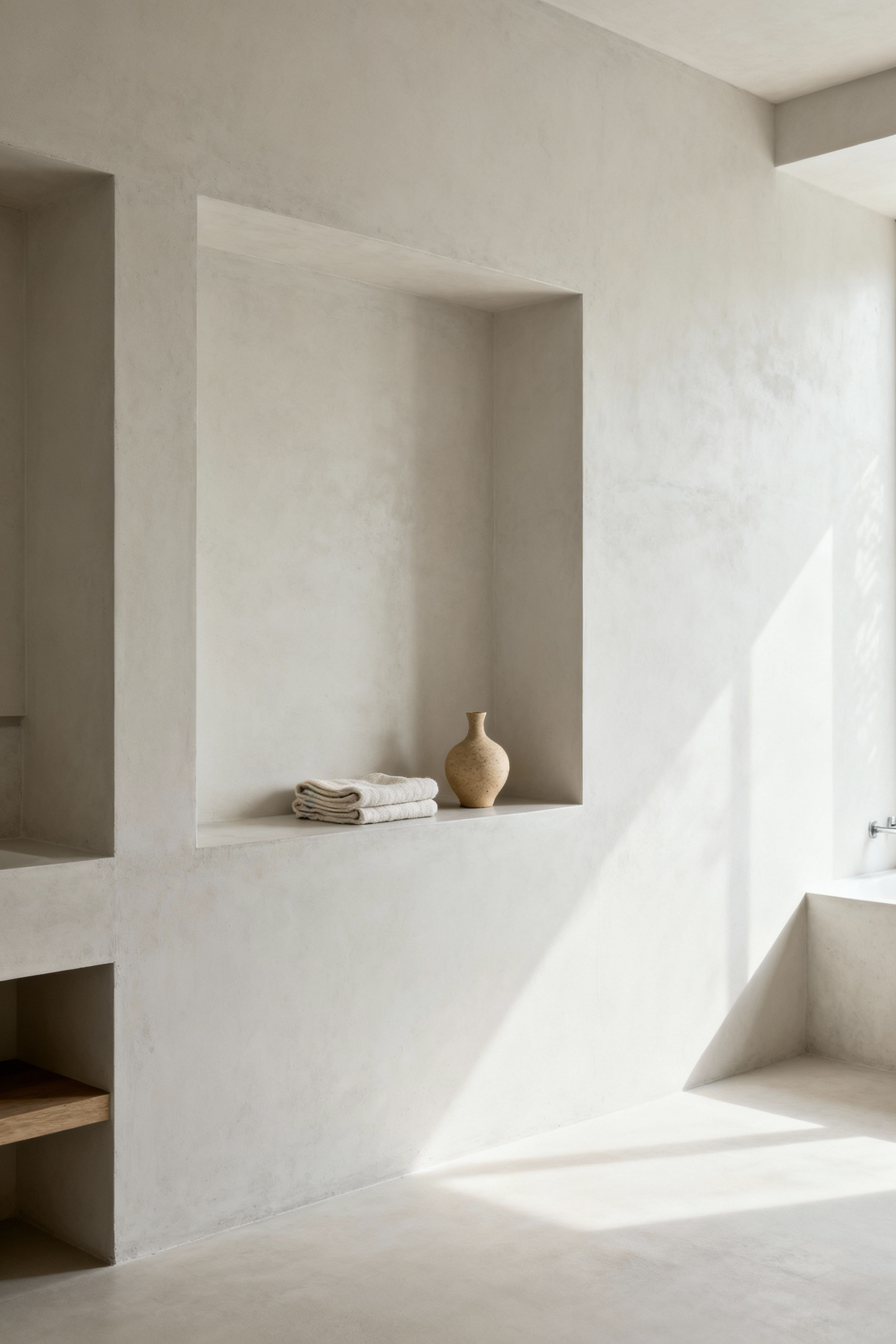
This philosophy extends naturally to bathroom storage organization by shifting our focus from filling space to curating it. Instead of lining a countertop with bottles, consider placing them within a discreet drawer, leaving the surface clear except for a single, unadorned ceramic soap dish. The quiet plane of the counter becomes a source of calm. On a shelf, this means arranging three items with intentional distance rather than cramming in ten. The space around them gives them importance and dignity. This approach isn’t about having less—it’s about allowing what you have to have more meaning.
2. Conscious Curation: Deconstructing Clutter with Intentional Discarding Rituals
Building on the foundation of Ma, conscious curation is the active practice of choosing what deserves to stay. This is a core tenet of Zen: intentionality in all things. An item earns its place in our sanctuary by serving a purpose or by bringing us a quiet joy. To deconstruct clutter, then, is not a chore but a thoughtful ritual.
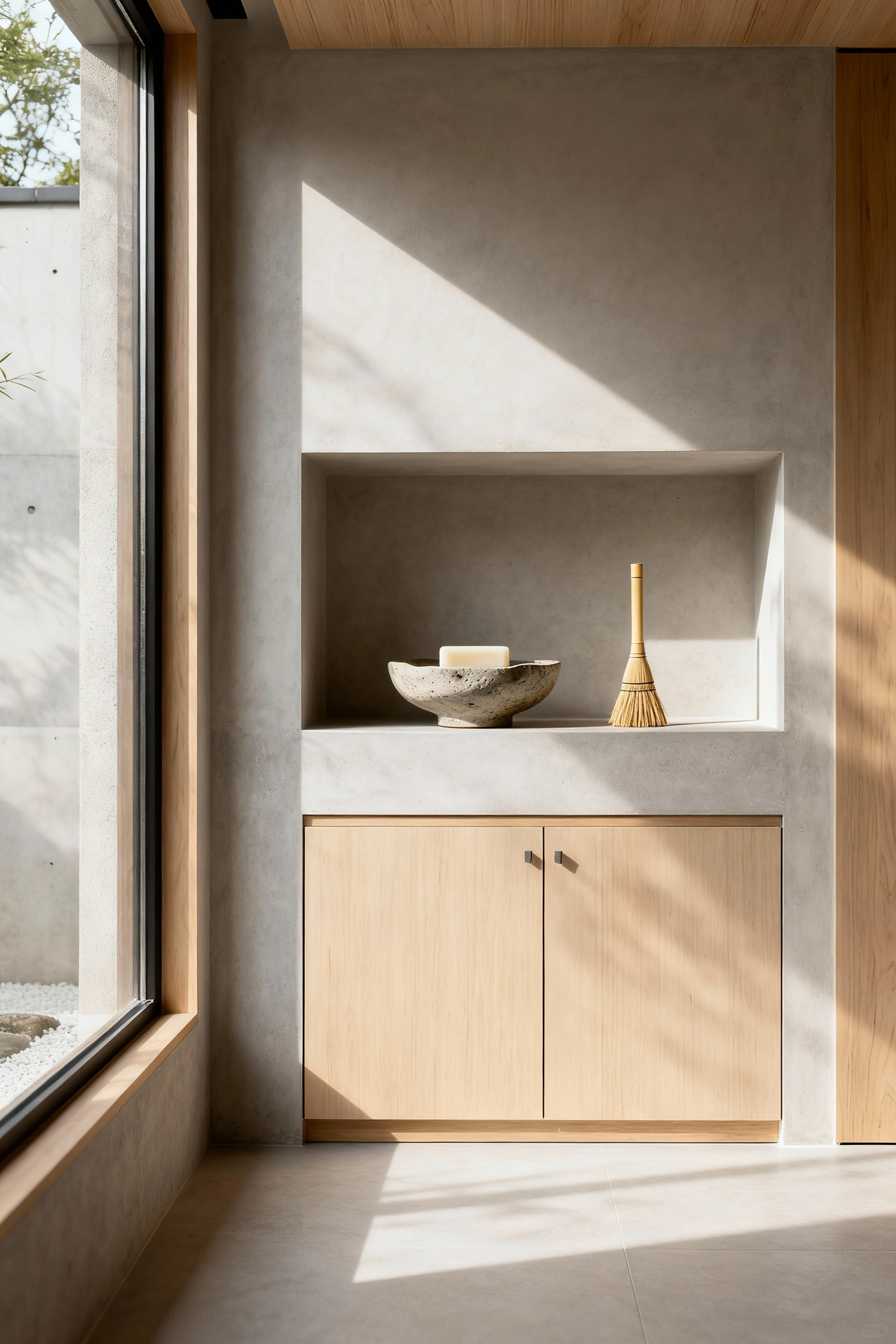
Periodically—perhaps with the changing of a season—empty your drawers and cabinets. Clean the empty spaces. Then, hold each item and ask if it truly belongs. Years of observing this practice have taught me that this is less about rules and more about feel. Does its texture, its function, its very presence contribute to the serenity you wish to build? Only what resonates should return. Adopting a simple ‘one in, one out’ policy for things like lotions and soaps maintains this hard-won balance, turning maintenance into a mindful habit rather than a daunting project.
3. Harmonizing Imperfection: Integrating Wabi-Sabi Through Authentic Materiality Selection
Wabi-Sabi is a worldview centered on the acceptance of transience and the beauty of imperfection. It is the quiet appreciation for a crack in a ceramic cup, the soft fading of natural linen, the grain of weathered wood. It stands in gentle opposition to our modern obsession with the new and flawless.

When choosing items for bathroom storage organization, this invites us to select materials that live and breathe. A hand-woven seagrass basket for towels offers not just storage but texture and warmth. A small stool of reclaimed elm, its surface marked by a former life, brings a story into the room. A ceramic tray with an uneven glaze feels more personal and grounded than sterile plastic. What really gets me is how these authentic materials connect us to nature and time. They infuse a space with a soul that mass-produced perfection can never replicate.
4. The Art of Concealment: Strategically Eliminating Visual Noise with Discreet Integration
The principle of kanso, or simplicity, often involves the artful concealment of life’s necessities. This is not about hiding things in shame, but about creating an uninterrupted visual plane to calm the mind. When functional items recede, serenity can come forward.

From my traditional Japanese architecture background, I learned that the most elegant solutions are often those that disappear into the structure itself. Consider a medicine cabinet with a mirrored front, set flush with the wall. Or vanity drawers with no visible hardware, opening with a gentle push. Storage should feel as if it has grown from the room itself. Opaque, lidded boxes in a color that matches the shelving can contain life’s small necessities without shouting their presence. The goal is to create a visual quiet, where the eye is not snagged by the visual noise of our many possessions. This allows the room to feel more expansive and peaceful, no matter its size.
Cultivating Serenity: Embracing Japanese Principles of Minimalist Cohesion (Part 2)
We now move from what is present in the room to what we allow to enter. True harmony is not a state we achieve once, but a balance we must actively maintain. This is where a discipline of thoughtful acquisition becomes the most powerful tool for order. By mindfully considering every new object, we pre-empt clutter before it can ever take root.
5. Anticipatory Design: Pre-empting Accumulation with Thoughtful Procurement Disciplines
The most profound form of organization is not arranging what you have, but consciously limiting what you acquire. This is anticipatory design. It is a philosophy that shifts the focus from decluttering to pre-empting. At its heart is the concept of yohaku no bi, the beauty of what is left empty. Every potential acquisition must earn its place by proving its utility and its ability to exist in harmony with the space.

This means before purchasing a new storage container or even a new bottle of soap, we must pause. Ask: is this truly necessary? Does its form align with the calm I wish to create? In my experience with Japanese design principles and minimalism, this simple pause is the most effective tool against clutter. Favor items made from natural, durable materials that will age with grace. Consider multi-functional pieces—a small stool that can hold a towel or serve as a seat. Every object becomes a considered choice, not an impulse.
This practice, applied to bathroom storage organization, means we resist the urge to buy solutions for problems that don’t yet exist. We don’t buy a dozen matching bins just in case. Instead, we assess a genuine need, then find the single, most beautiful and functional piece to meet it. By intentionally leaving some shelves or drawers partly empty, we cultivate Ma—the quiet space that provides visual relief and psychological calm. This turns the act of procurement from a consumer habit into a curatorial practice.
Ultimately, this way of thinking becomes integrated into one’s life. A ‘pause before purchase’ becomes second nature. You begin to appreciate the elegance of having just enough. This breaks the endless and exhausting cycle of acquiring, organizing, and decluttering. By practicing anticipatory design, we transform bathroom storage organization from a recurring task into a sustained state of being. It is the celebration of a life thoughtfully lived, unburdened by the excess that distracts from what truly matters.
Tactile Tranquility: Harmonizing Form and Function Through Deliberate Materiality (Part 1)
A truly serene space speaks not just to the eyes, but to the hands. The materials we choose for storage are not simply containers; they are part of the daily ritual of living. Selecting them with intention, for their texture, warmth, and story, elevates the simple act of organization into a sensory experience.
6. Employing Bamboo and Hinoki: Harnessing Organic Warmth and Anti-Microbial Properties for Storage Vessels
We begin with materials that connect us directly to nature. Bamboo, with its clean lines and warm tones, embodies shizen, or naturalness. It suggests both strength and flexibility. As a material for bathroom storage, a slender bamboo tray for small bottles or a set of drawer dividers brings a sense of organic order without feeling heavy or intrusive. It provides structure with a light, airy presence.
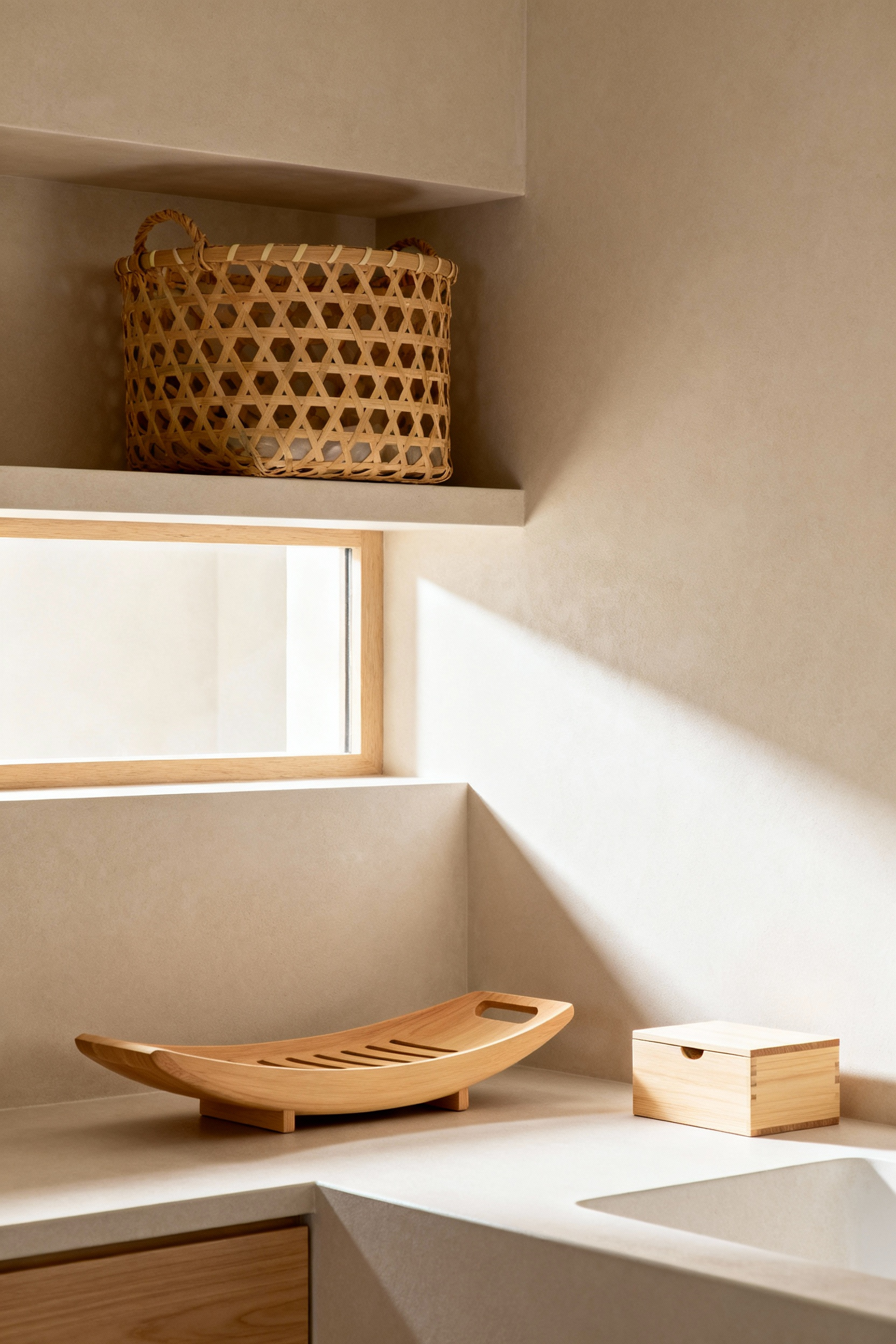
This thinking deepens with the use of hinoki cypress. This wood is sacred in Japan, known not only for its delicate grain but also for its natural calming scent and antimicrobial properties. It is the perfect material for the humid environment of a bathroom. I’ve seen a simple hinoki bath stool or a small box for cotton pads transform a space, subtly purifying the air and adding a spa-like quality. These materials are not just beautiful; they are functional in ways that resonate with well-being.
7. Ceramic Vessel Integration: Elevating Daily Essentials with Handcrafted Aesthetic Containers
Ceramics ground a space. They connect us to the earth and to the hand of the artisan. Using ceramic vessels for bathroom storage organization is a way of honoring our daily essentials. The principle of wabi-sabi lives in these pieces—in the slight irregularities of the glaze or the unique shape of a hand-thrown jar.
Instead of a plastic cup, a cool, smooth ceramic tumbler for toothbrushes adds a moment of quiet luxury. A lidded ceramic pot for bath salts or cotton balls becomes a small sculpture on a shelf, its contents protected and its form pleasing to the eye. When choosing these pieces, I tell my minimalism enthusiasts and cultural design admirers to favor matte finishes and simple, clean forms. Their weight and solidity provide a satisfying counterpoint to lighter materials like bamboo, creating a balanced, harmonious landscape.
8. Woven Natural Fibers: Infusing Texture and Breathability with Seagrass or Rattan Storage Elements
Where wood and ceramic offer solid forms, woven fibers like seagrass and rattan introduce texture, lightness, and breathability. They create a gentle visual softness, a welcome contrast to the hard surfaces of tile and porcelain. Their structure embodies oku, a sense of layered depth, inviting the eye to linger.

These baskets are perfect for holding soft things. Rolled towels stored in a large seagrass basket can breathe, preventing mustiness. Woven containers are also ideal for discreetly holding spare toilet paper or gathering laundry. Their organic texture and warm, natural tones blend seamlessly into a serene palette. The choice to use these materials is a choice to infuse the room with comfort and a connection to timeless craft traditions.
9. Acknowledging Transience: Opting for Patina-Rich Materials that Age Gracefully with the Environment
The most beautiful spaces are not static; they evolve over time. This aligns with wabi-sabi’s appreciation for the passage of time. Instead of choosing materials that fight against age, we can select those that welcome it, developing a rich patina that tells a story.
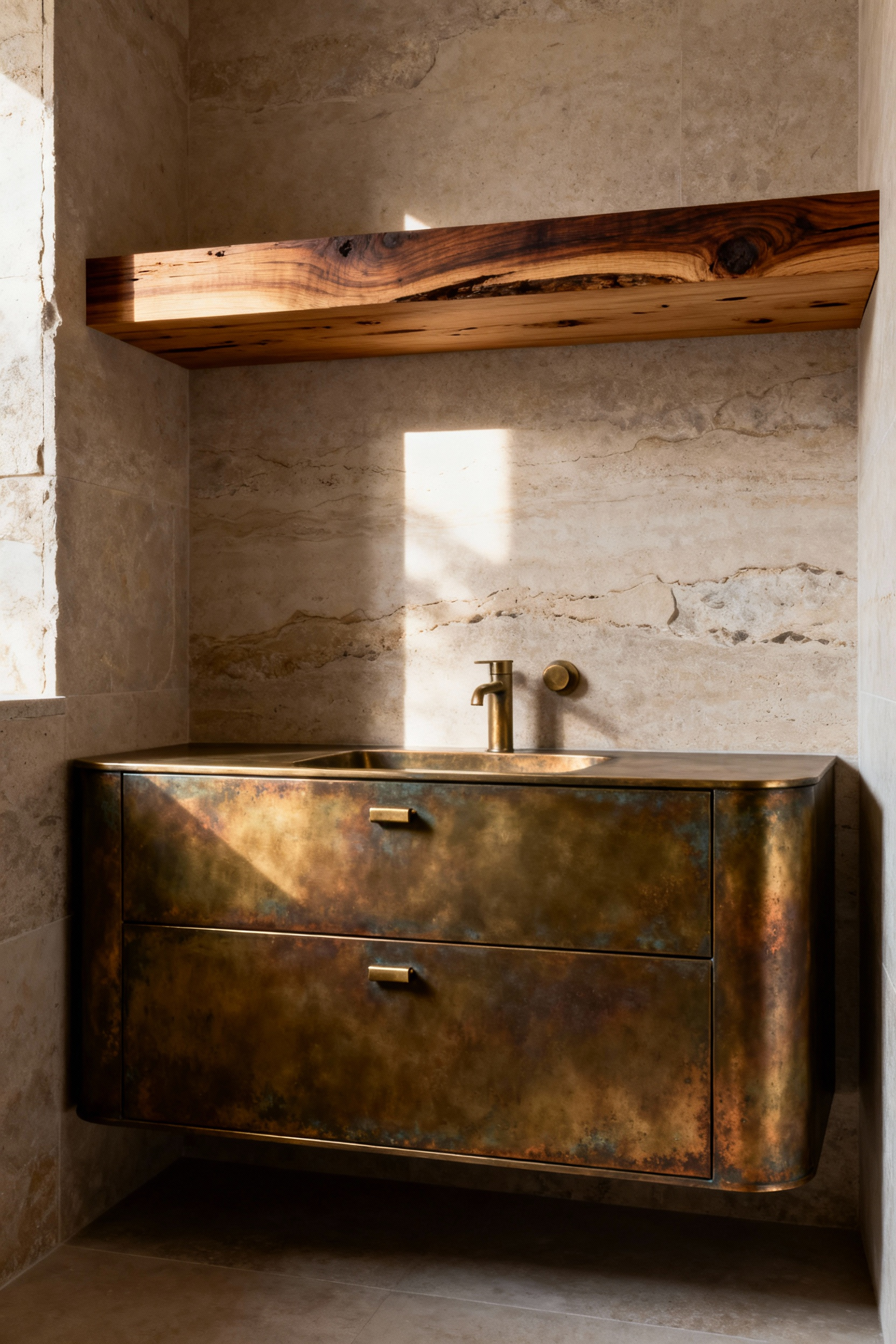
Consider unlacquered brass for cabinet pulls or a small dish. With time and use, it will deepen in color, its surface marked by daily touch. This natural aging process gives the object a history and a sense of belonging. The same is true for certain unfinished woods that subtly change color with exposure to light. Opting for these patina-rich elements in your bathroom storage organization is an act of mindfulness. It is an embrace of authenticity over artificial perfection, creating a space that feels lived-in and loved, maturing gracefully alongside you.
Tactile Tranquility: Harmonizing Form and Function Through Deliberate Materiality (Part 2)
Building on our appreciation for texture and natural essence, we now consider the role of transparency. Lightness, both physical and visual, is a key component of a serene space. How we use materials that interact with light can either create a sense of openness and honesty or contribute to visual weight. This is a subtle but powerful aspect of design.
10. Transparent Enclosures: Thoughtfully Employing Glass for Unobtrusive Visual Access and Ordered Display
The Japanese aesthetic of yohaku no bi, the beauty of what is left unsaid or unfilled, also applies to how we see. It is about a mindful presentation of what is essential. In this spirit, glass becomes more than a material; it is a philosophy. Its transparency encourages an honest approach to organization. There is nowhere to hide clutter. Glass gently forces a discipline of order.
The nature of glass itself—strong yet visually weightless—allows light to flow freely, making a space feel larger and more open. While perfectly clear glass demands perfect order, frosted or fluted glass offers a beautiful compromise. It hints at the forms within, softening their presence while still maintaining that feeling of lightness. In traditional Japanese architecture, screens of paper (shoji) often serve this purpose, diffusing light and suggesting space beyond. Modern glass can play a similar, poetic role.
When applied to bathroom storage organization, this principle transforms how we think about cabinetry and shelving. Floating glass shelves seem to almost disappear, allowing the items on them—carefully chosen and arranged—to become the focus. Integrating clear acrylic dividers inside a drawer elevates its internal logic, turning a search for an item into a simple, clear gesture. What I’ve seen play out when people adopt this is a fundamental shift in behavior. When your daily items are behind a transparent door, you naturally place them back with more care and intention.
Ultimately, choosing to use glass is a commitment to a lifestyle of mindfulness. The daily act of interacting with these transparent elements becomes a small, repeated ritual of maintaining order. It subtly discourages the accumulation of things that are not beautiful or useful enough to be seen. The result is a space that feels not only organized but also coherent and deeply calming, reinforcing the bathroom’s role as a true sanctuary for the mind and body.
Spatial Synergies: Orchestrating Ergonomics and Visual Continuity within the Sanctum (Part 1)
A harmonious space is one where movement feels effortless and every object is exactly where it needs to be. This is about more than just aesthetics; it is about the quiet conversation between your body and the room around you. We will now explore how to orchestrate the layout and flow of your bathroom, making order feel intuitive and serene.
11. Maximizing Verticality: Implementing Stackable Tiered Solutions and Wall-Mounted Apothecary Cabinets
The concept of ma teaches us to see the value in space, including the vertical space above our counters. Instead of seeing this as emptiness to be filled, we can see it as an opportunity for graceful, upward organization. This allows horizontal surfaces to remain clear, promoting that essential feeling of calm.

Tiered shelving, whether on a counter or in a cabinet, brings order to smaller items without adding visual bulk, especially when crafted from light materials like bamboo or fine metal. It allows for a logical separation—perhaps morning items on one level, evening on another. Complementing this are wall-mounted apothecary cabinets. Their slender profiles offer elegant concealment for the many small things a bathroom requires, preserving the pristine feeling of the space below. From my background in architecture, I see this as creating a cleaner, more intentional sightline. By drawing the organization upward, you give the room—and your mind—space to breathe.
12. Integrated Niche Shelving: Embedding Recessed Storage for Seamless Aesthetic and Utilitarian Flow
This idea of seamlessness leads us to what the Japanese call mie-gakure, the interplay of the hidden and the seen. The most elegant storage is that which feels like part of the architecture itself. Recessed niche shelving is a perfect example. It does not protrude into the space; it is carved from it.
When designing a niche, the material choice is critical. It should either blend perfectly with the surrounding tile or offer a quiet, pleasing contrast, perhaps lined with a single slab of honed stone or a dark, water-resistant wood. Placed within a shower for shampoos or beside a vanity for daily skincare, these niches eliminate visual clutter from external surfaces. I’ve noticed this creates a profound psychological effect: when storage feels integrated and intentional, the entire room feels more cohesive and calm. It turns retrieval of an item into a simple, fluid gesture.
13. Vanity as Sanctuary: Concealing Daily Imperatives within Bespoke Under-Counter Drawer Systems
The vanity can be the calm center of the bathroom, but only if its surface is free. We can achieve this by embracing yugen, a principle appreciating that which is not fully revealed, a subtle and profound grace. The interior of a drawer, when properly organized, embodies this principle. It is a private world of perfect order, hidden from view.
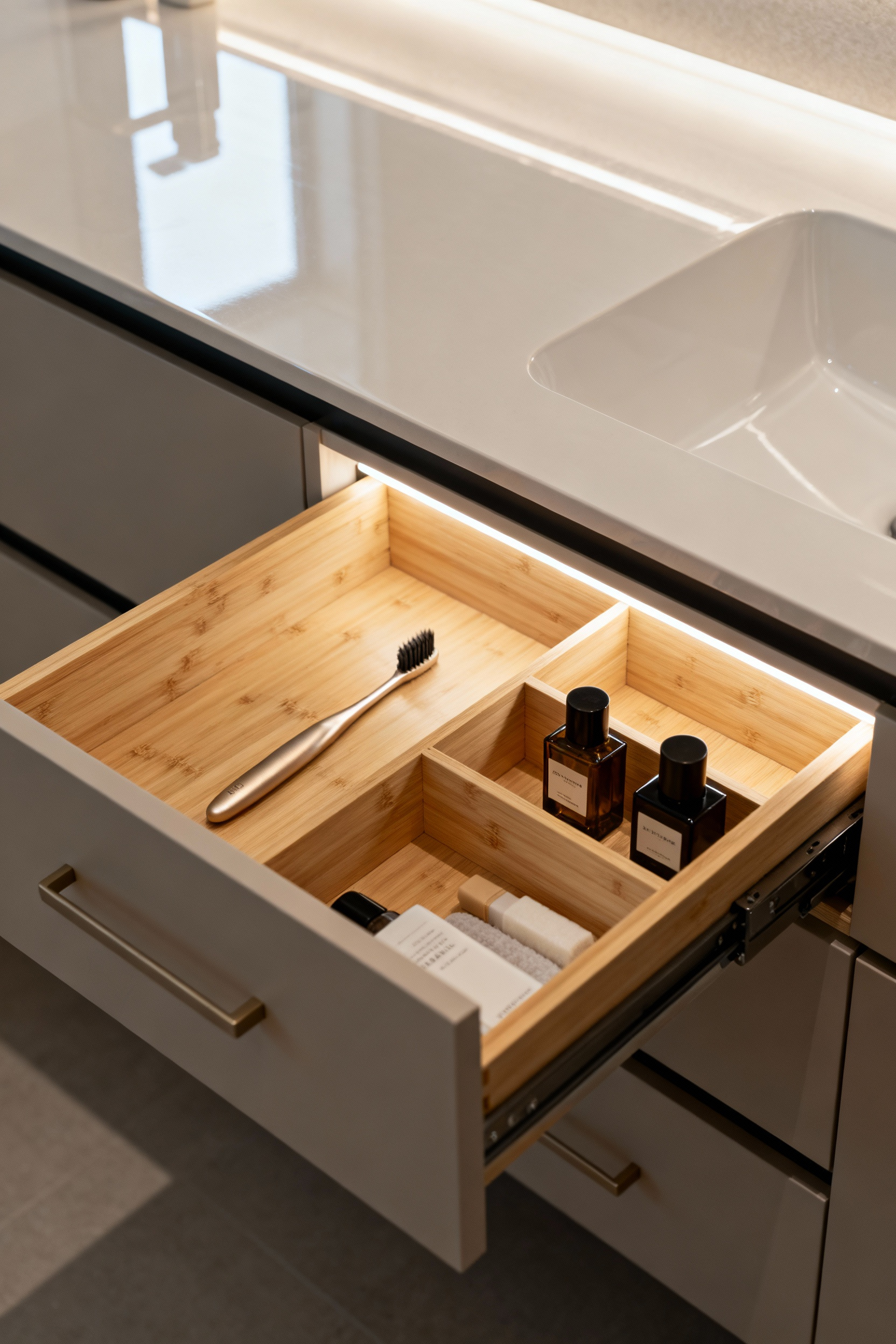
High-quality, soft-close drawers are a start, but true harmony lies within. Custom-fitted dividers made of wood or bamboo create a designated home for every item, from brushes to skincare bottles. This is not about rigid compartmentalization but about creating a logical, intuitive landscape. Deeper drawers can hold taller items, while shallow ones can organize cosmetics. When every object has its precise place, the daily routine becomes less of a search and more of a quiet, efficient ritual. This transforms the unseen into a source of personal satisfaction and order.
14. Modular Component Integration: Customizing Configurations with Interlocking Divisions and Compartmentalized Trays
Life is not static, and our storage systems should not be either. The principle of kanso, or simplicity, also speaks to an elegant adaptability. Modular components—interlocking dividers, stackable trays—offer this flexibility, allowing the internal landscape of your drawers and cabinets to evolve with your needs.
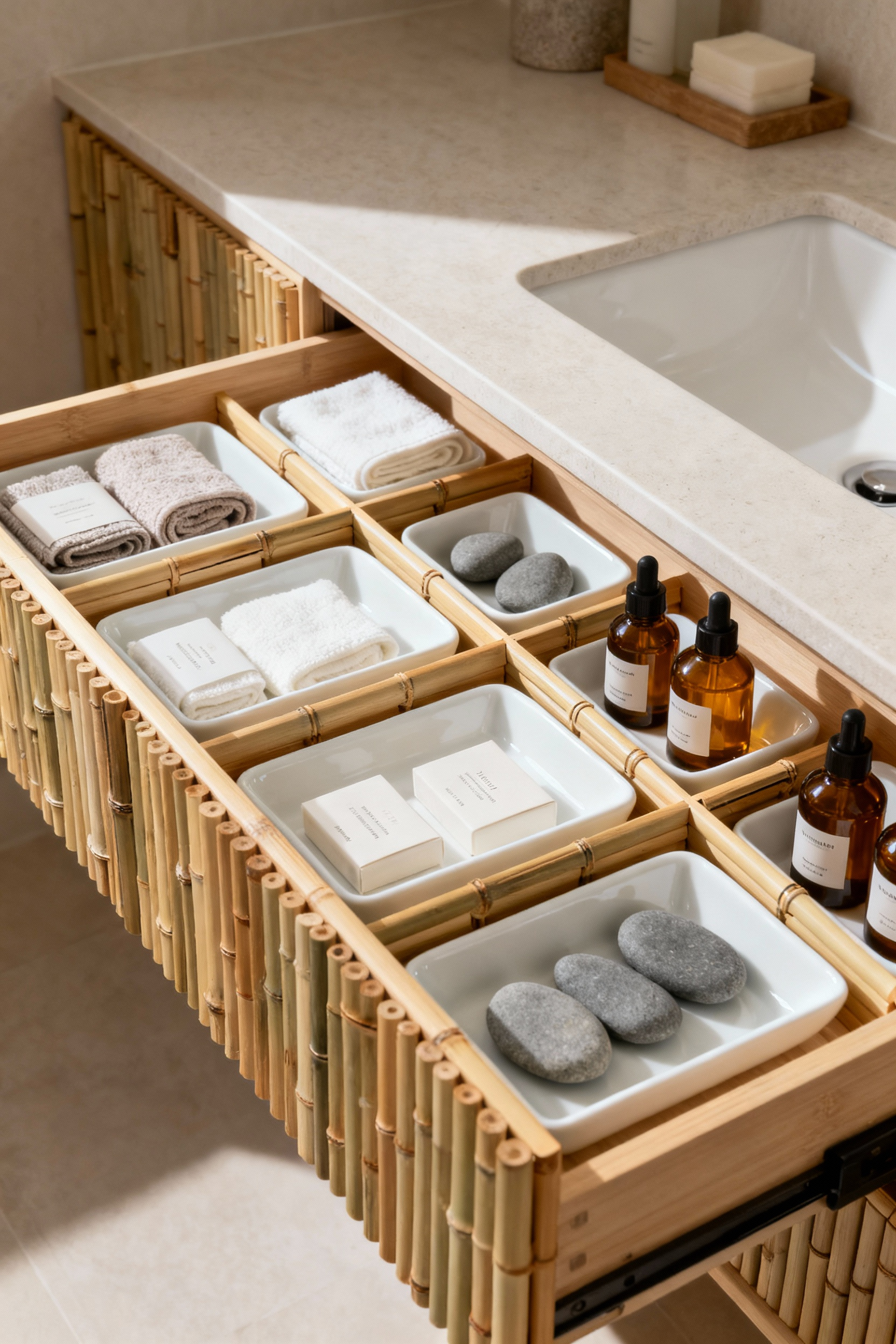
Choose modular pieces made from quiet, resilient materials like bamboo, clear acrylic, or matte ceramic. These act as the internal architecture of your storage, creating a personalized grid that can be reconfigured as your routine changes or you acquire new products. In traditional Japanese design, we understand that flexibility within a defined structure is key to longevity. This approach empowers you to maintain order in a way that feels responsive and personal, ensuring your system continues to serve you perfectly over time. It makes bathroom storage organization a living, adaptable practice.
Spatial Synergies: Orchestrating Ergonomics and Visual Continuity within the Sanctum (Part 2)
We continue our journey into the flow of the bathroom, considering how storage can bridge different areas of activity. True synergy is achieved when the design anticipates your movements, making necessary items available exactly where you need them. This is about creating a silent, intuitive partnership between you and your environment.
15. Bi-Directional Access: Designing Storage That Serves Multiple Functional Zones with Intuitive Reach
In Japanese aesthetics, the concept of kankei (関係) explores the deep-seated relationships between elements. A space is not a collection of separate parts, but an interconnected whole. Applying this to bathroom storage organization leads us to create solutions that serve more than one purpose or zone, reflecting the natural flow of our routines. It is a thoughtful design that anticipates our next move.
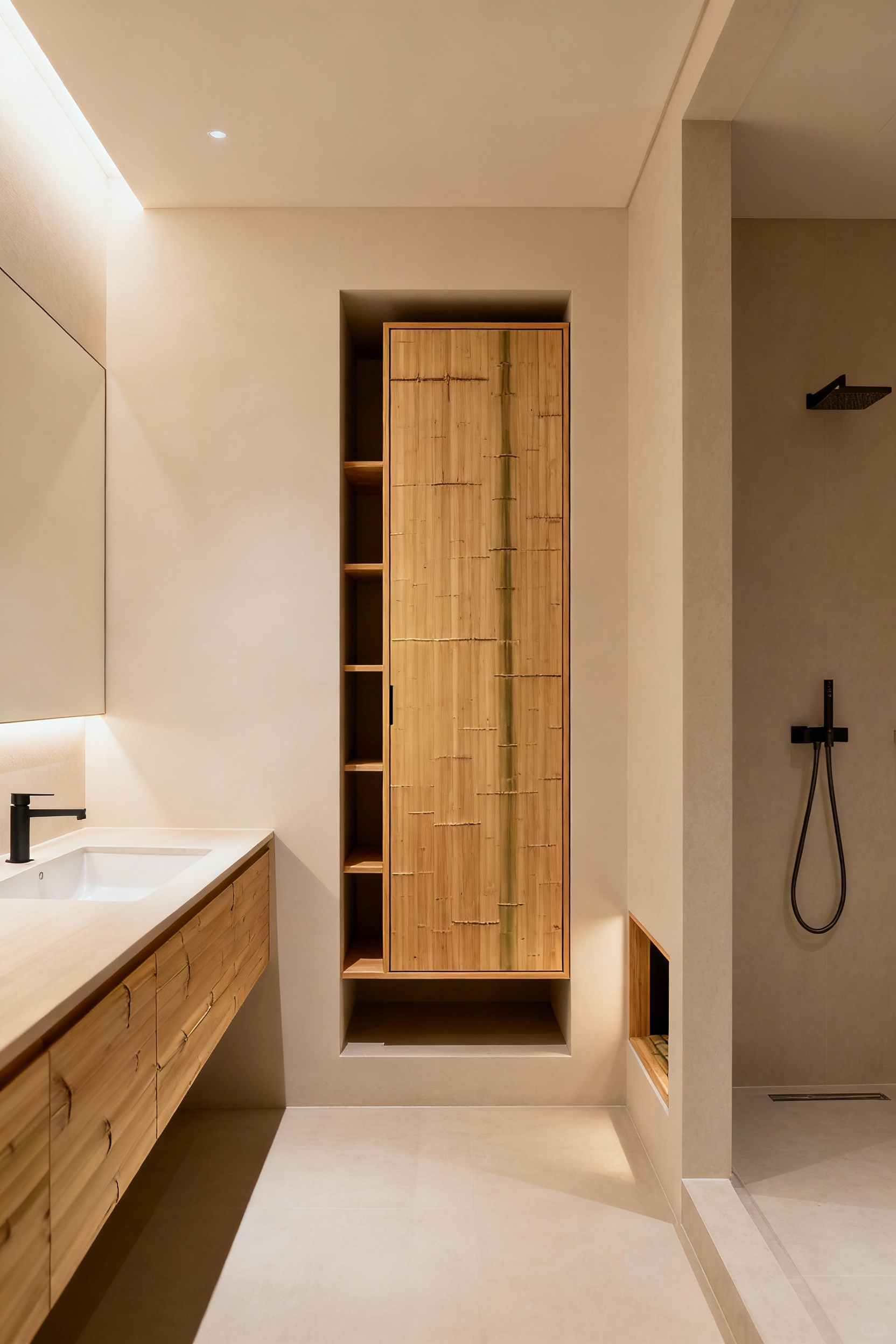
Think of materials that can bridge spaces gracefully. A sliding panel of frosted glass can conceal a cabinet that opens to both the main bathroom area and a separate water closet. Meticulous joinery can create pass-through niches or pivoting shelves that make items accessible from different points. I learned this when studying traditional fusuma (sliding doors) and how they redefine spaces; we can apply that same fluid logic to storage. The hardware should be silent and concealed, the motion smooth. The goal is to reduce friction—both physical and mental.
Imagine a half-wall between the shower and vanity. This partition could house shelving accessible from both sides—towels facing the vanity, shampoos facing the shower. A well-designed medicine cabinet might even rotate internally, allowing access to its contents from two different sides of a counter. This intelligent foresight streamlines movement, turning multiple steps into a single, effortless reach.
This deep integration of function transforms daily life. It brings a quiet grace to our routines, eliminating awkward movements and a cluttered mind. You begin to feel the room is working with you. This is the essence of superior bathroom storage organization: it is not just about placing things, but about understanding the relationships between actions, objects, and spaces to create an environment of profound, intuitive ease.
Sustained Sanctuary: Ritualizing Order and Conscious Daily Maintenance (Part 1)
Creating a serene bathroom is one step. Maintaining it is a lifelong practice. This final section is about the rituals that sustain order, transforming it from an occasional effort into an effortless state of being. Through conscious daily habits, we ensure our sanctuary remains a place of unwavering calm.
16. Ritualized Replenishment: Instituting a Deliberate System for Inventory Management and Refill Timing
The Zen concept of mottainai, or a regret concerning waste, can guide our approach to consumption. It encourages a mindful awareness of what we have and what we truly need. Ritualized replenishment is the practice of maintaining this balance—ensuring you have enough without succumbing to the chaos of overstocking.
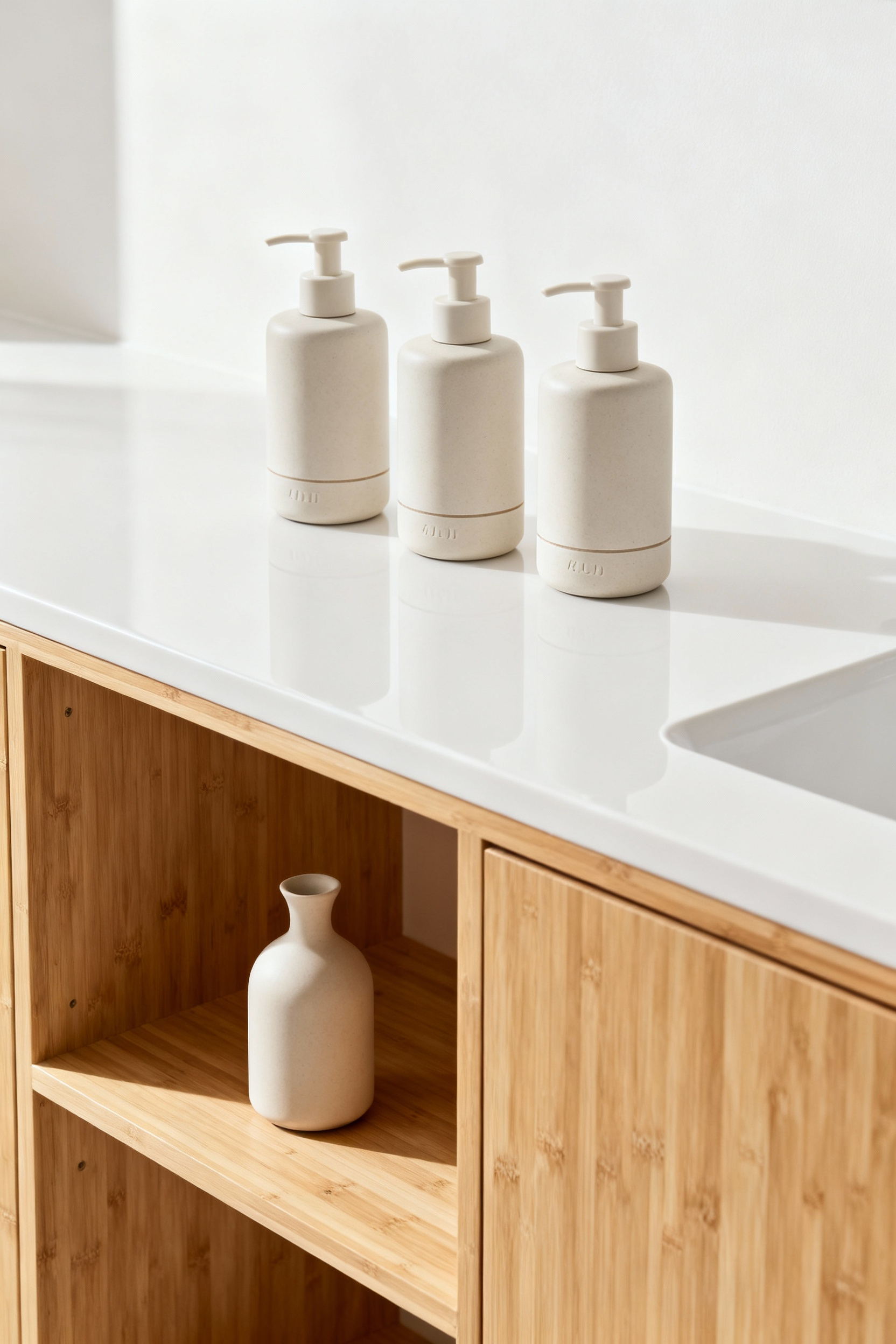
This starts with observation. Instead of buying in bulk on impulse, take note of how quickly you use certain products. This awareness allows you to create a replenishment rhythm based on reality, not anxiety. It is a conscious rejection of consumerist accumulation in favor of a thoughtful, needs-based approach. The concept of ma applies here as well; a bit of empty space in the backup supply cabinet is a sign of a healthy, controlled system.
For your bathroom storage organization, this means creating a designated home for one backup of each essential item. When you take that backup to use it, that is your signal to add the item to your shopping list. No more, no less. This simple system prevents both running out and overflowing. The storage remains calm and ordered because it is never strained beyond its intended capacity. It is a system built on foresight and restraint.
Integrating this into your life fosters a quiet sense of preparedness and calm. The small mental burden of tracking supplies simply disappears. It turns a chore into a simple, mindful check-in. This practice reflects a deep respect for your resources and your space, embedding the principles of Zen into the practical management of your home and contributing to a sustained sense of domestic peace.
17. Adapting with Kanso: Embracing Simplicity in Form and Function for Evolving Needs
Kanso is a principle that celebrates a beauty found in simplicity and the elimination of the non-essential. In our homes, Kanso also speaks to adaptability. Our lives change, and a truly serene space must be able to change with us, gracefully and without chaos. It means choosing items and systems with an inherent flexibility.
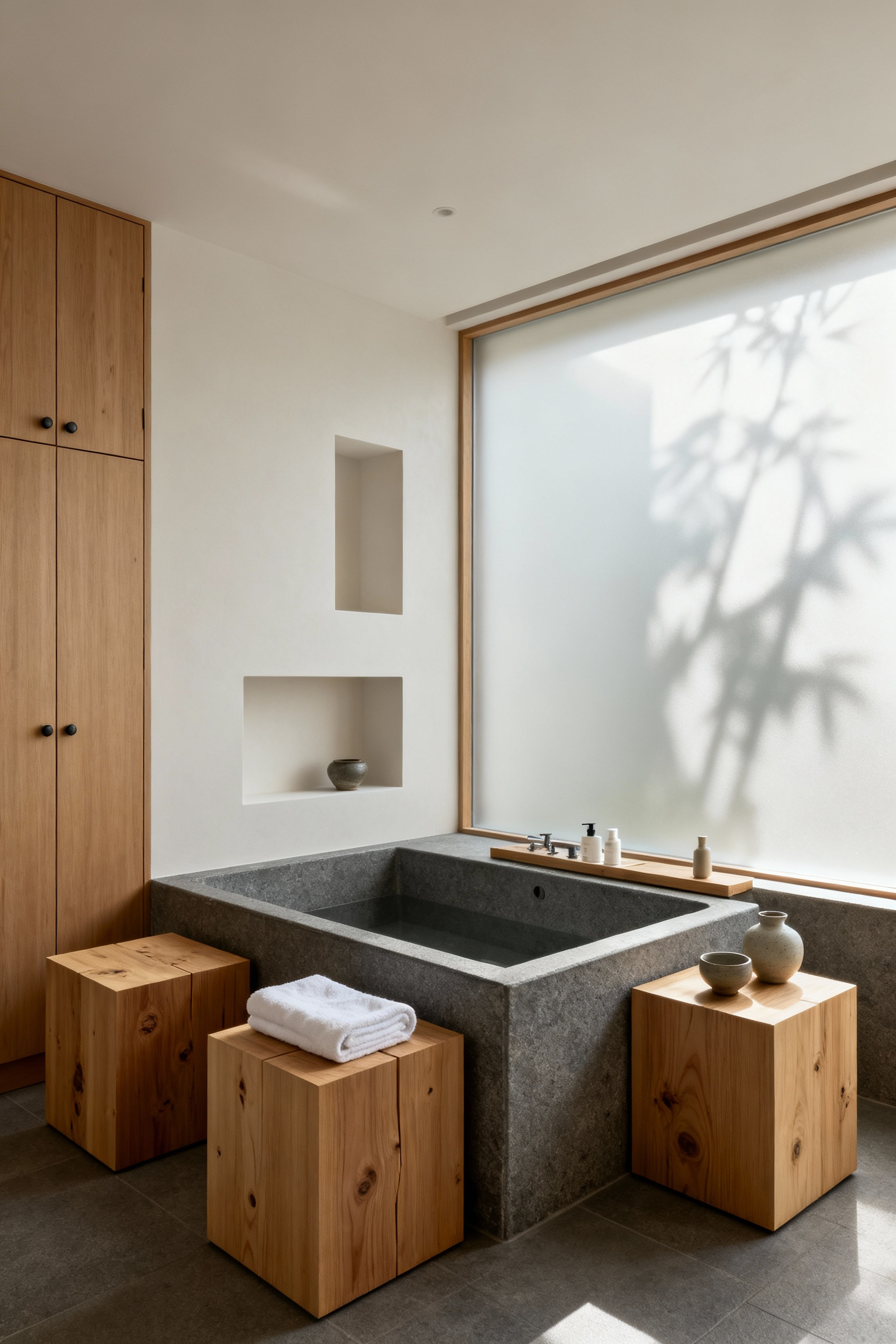
When selecting storage, favor modular pieces and multi-functional items. A set of simple, beautiful baskets can be reconfigured as your needs shift. Clear containers are versatile because their purpose is not overly defined. What I tell my clients is to favor elegance in function over decoration; a beautifully made object needs no adornment. The material palette should be simple and cohesive, allowing different pieces to work together harmoniously.
In practice, a Kanso-inspired bathroom avoids overly specific, built-in organizers. Instead, it relies on open zones and adaptable containers. If a new skincare routine requires different sized bottles, the system can easily adjust. Open shelving embodies Kanso, but it requires discipline—only essentials that are themselves simple and beautiful should be displayed. The entire approach to bathroom storage organization becomes fluid, responsive, and alive.
Living with Kanso is an ongoing practice of discernment. It’s a quiet commitment to questioning what is truly necessary and releasing what is not. This mindset is liberating. The mental clarity that comes from an adaptable, uncluttered environment is immense. Decisions become easier because the system itself is simple and intuitive. The bathroom remains a tranquil space that flexes with the currents of life, a testament to the enduring power of simplicity.
18. Mindful Decantation: Utilizing Uniform Dispensers for Product Harmony and Visual Coherence
The principle of seijaku refers to the tranquility found in stillness and quiet. In our visually loud world, mindful decantation is a powerful act of creating seijaku. It involves moving products like shampoo, soap, and lotion from their chaotic commercial packaging into a set of uniform, beautiful dispensers. This simple act silences the visual noise of branding and creates an immediate sense of harmony.

The choice of dispensers is a chance to engage with beautiful materials. Frosted glass, matte ceramic, or dark amber bottles—select a style that contributes to the calm of your space. The uniformity is key. A line of identical, understated bottles on a shower niche or countertop is inherently more peaceful than a jumble of competing shapes and colors. You can use subtle, minimalist labels or even learn to distinguish contents by their color or viscosity.
The effect on your bathroom storage organization is profound and immediate. A visually coherent set of products transforms a cluttered area into a curated display. This principle can extend to other items as well; cotton swabs and bath salts look more elegant in simple glass or ceramic jars than in their store packaging. By unifying the vessels, the architectural purity of your bathroom can finally take center stage.
This practice elevates a daily routine into a small ritual. Reaching for a beautiful, simple dispenser is a more mindful, pleasing experience. It also encourages more sustainable habits, like buying products in bulk refills, reducing plastic waste. Mindful decantation is far more than an aesthetic trick; it is a way to instill a deep and abiding sense of intentional order into the fabric of your daily life.
19. Regular Seshin Practice: Engaging in Micro-Purging Rituals for Continual Decluttering
In Zen practice, Seshin is a period of intensive meditation and clearing of the mind. We can apply this concept to our physical space through small, regular purging rituals. This acknowledges a simple truth: clutter is not a singular event but a slow, steady accumulation. Maintaining order requires constant, gentle vigilance.
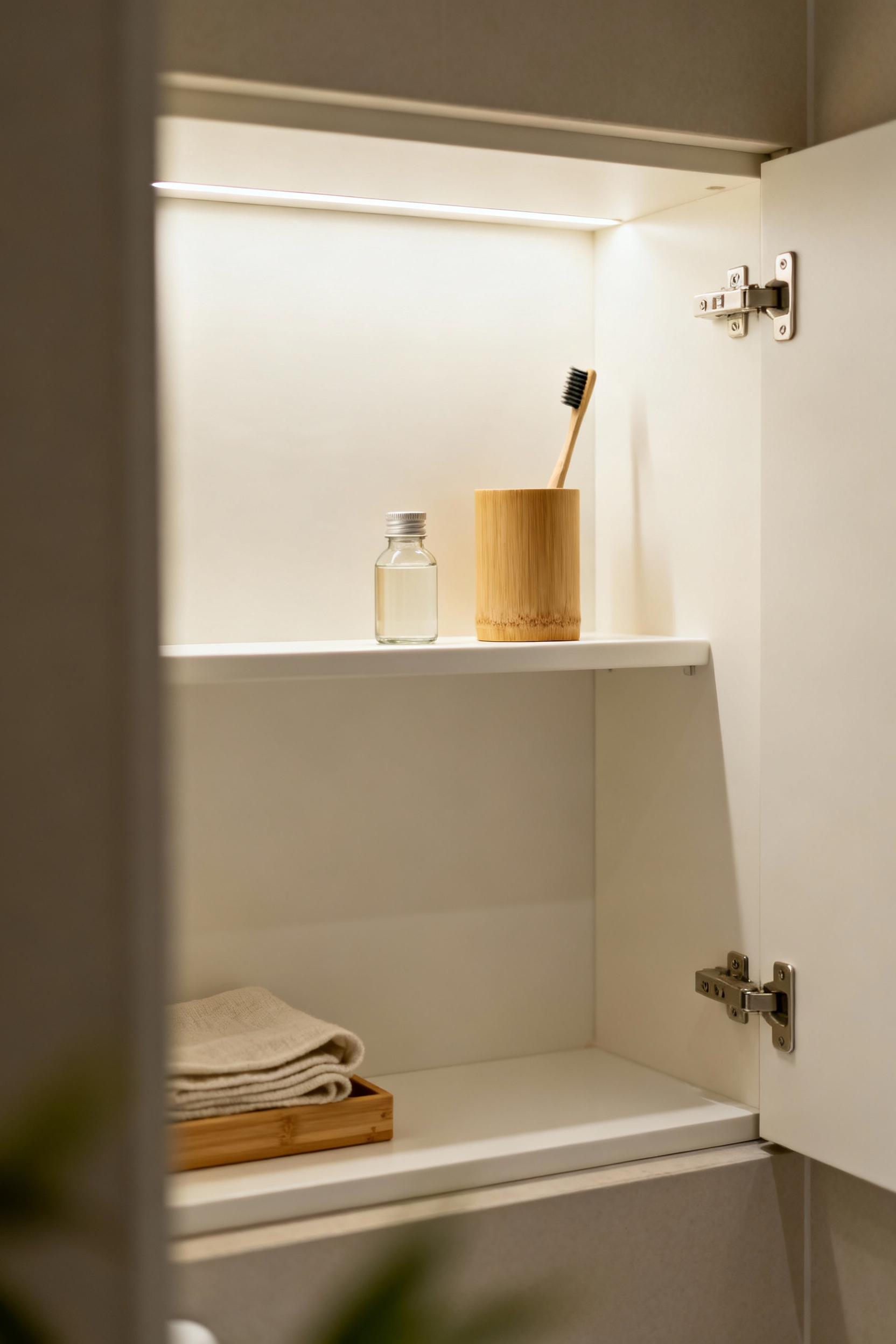
This is not a massive spring-cleaning. It is a focused, five-minute ritual. Once a week, choose one small zone—a single drawer, the medicine cabinet, the shower caddy. Quickly scan for and remove anything that is expired, empty, or no longer serving you. A forgotten product sample, a nearly-finished tube of ointment. This consistent practice of ‘mind-heart purification’ for your belongings keeps things from ever reaching an overwhelming state.
This changes bathroom storage organization from a daunting project into an ingrained, easy habit. The ‘organizational debt’ never grows large. By swiftly addressing the small accumulations, you preserve the harmony of the entire system. What really gets me is the lightness people feel after adopting this; it’s a release of both physical and mental weight.
Integrating this Seshin-inspired practice cultivates a profound respect for your sanctuary. It fosters a proactive relationship with your belongings, one rooted in mindfulness and impermanence. The sustained calm that results is empowering. It is not just about being tidy; it is a practice that grounds you in the present, reinforcing the peace that comes from a life consciously and simply lived.
Sustained Sanctuary: Ritualizing Order and Conscious Daily Maintenance (Part 2)
Finally, we arrive at the highest purpose of organization: to create a space that not only functions perfectly but also invites quiet contemplation. This is where the physical arrangement of our belongings begins to influence our state of mind, turning the bathroom into a place for genuine reflection and presence.
20. Integrating Reflective Spaces: Designing Storage that Encourages Personal Contemplation and Presence
The truest sanctuary is one that offers space for the mind to settle. Here, the principle of Ma finds its deepest expression. A clear surface is more than just clean—it is an invitation to pause. In our bathroom storage organization, we must consciously design these moments of visual stillness. This is not about hiding everything, but about curating what remains visible to encourage, rather than distract from, introspection.
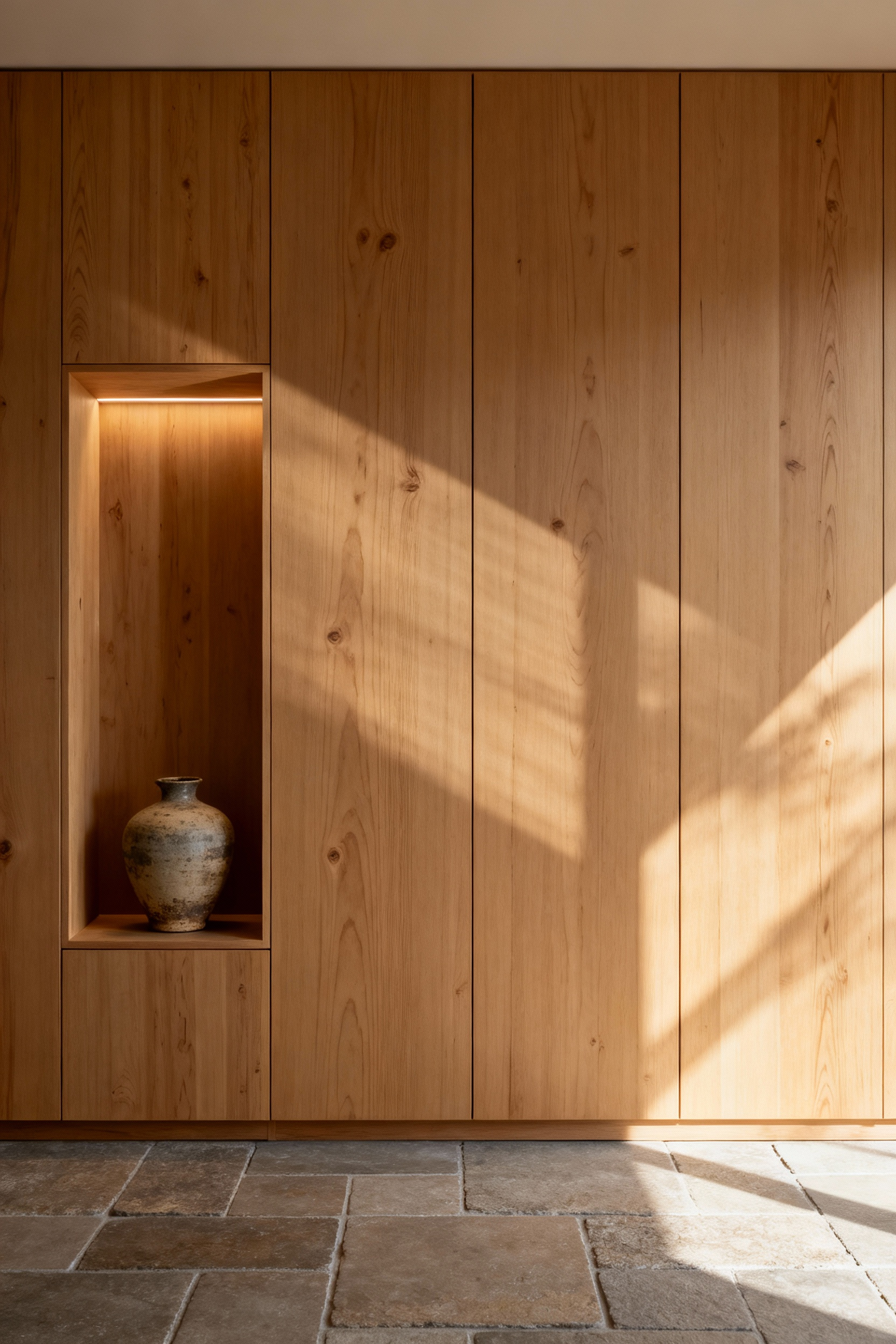
The materials we choose can support this reflective mood. Surfaces that absorb light rather than reflecting it—like matte finishes, honed stone, and natural wood—create a softer, calmer atmosphere. Storage should feel integrated, with hidden pulls or push-to-open mechanisms that maintain an unbroken visual plane. In traditional Japanese interiors, every line and junction is considered for its effect on the spirit; we can bring this same precision to our cabinetry.
Practically, this means transforming functional elements into opportunities for mindfulness. Instead of a cluttered shelf, envision a single, recessed niche holding just one beautiful object—a smooth river stone or a small, artisanal soap. The emptiness around it gives it power. Vanities become unburdened altars for the simple rituals of the day, their surfaces clear save for the most essential and beautiful tools. Concealed storage handles the rest, preserving the vital tranquility that allows for true contemplation.
Ultimately, designing a bathroom in this way fosters a lifestyle of heightened awareness. The deliberate interaction with a space that is simple, beautiful, and calm becomes a daily practice in mindfulness. Each time you open a silent drawer or place an item back in its spacious home, you are reinforcing a habit of presence. Your bathroom then becomes more than a room for hygiene; it becomes a teacher, quietly guiding you toward a more centered and harmonious existence.
Conclusion
Through these twenty principles, we have journeyed far beyond the simple act of arranging objects. We have explored ‘The Art of Absence’ as a philosophy for living—a way of finding meaning not in what we own, but in how we choose to live with what is essential. Concepts like Ma and Wabi-Sabi are not just aesthetic terms; they are invitations to see our homes, and particularly our bathrooms, as spaces for quiet renewal.
By applying this wisdom, the process of bathroom storage organization is transformed. It becomes a mindful practice, a ritual of curation that brings a deep and lasting calm. This is not about achieving a fleeting state of perfection, but about cultivating an environment that supports an inner stillness day after day. I encourage you to see your bathroom through this lens—as a sanctuary whose harmony you can actively shape.
Embrace these ideas. Let the quiet power of intentional design resonate in this most personal space. In mastering the simple elegance of a well-ordered environment, you will discover that you are not just organizing a room; you are cultivating a more serene and conscious life.
